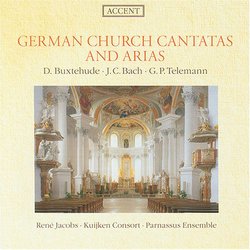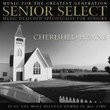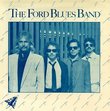| All Artists: Dietrich Buxtehude, Johann Christoph Bach, Georg Philipp Telemann, René Jacobs Title: German Church Cantatas and Arias Members Wishing: 2 Total Copies: 0 Label: Accent Plus Original Release Date: 1/1/2006 Re-Release Date: 1/1/1999 Album Type: Import Genres: Pop, Classical Styles: Vocal Pop, Opera & Classical Vocal, Forms & Genres, Concertos, Historical Periods, Baroque (c.1600-1750) Number of Discs: 1 SwapaCD Credits: 1 UPC: 750582472923 |
Search - Dietrich Buxtehude, Johann Christoph Bach, Georg Philipp Telemann :: German Church Cantatas and Arias
 | Dietrich Buxtehude, Johann Christoph Bach, Georg Philipp Telemann German Church Cantatas and Arias Genres: Pop, Classical
|
Larger Image |
CD DetailsSimilar CDs
|
CD ReviewsRe-issue of Rare German Vocal Repertoire from the 17th and 1 Leslie Richford | Selsingen, Lower Saxony | 06/04/2006 (3 out of 5 stars) "As with all those recordings on which Rene Jacobs stars as countertenor, the main problem here is his voice: Although Jacobs proves himself to be delightfully musical as far as interpretatory detail is concerned, his timbre is cold and hard, and as soon as the pitch gets higher, his falsetto sounds pressed and extremely unnatural. Today, he is, in Europe, one of the most successful conductors of early music repertoire, but his days as a singer were over as soon as the art of countertenor began to produce singers whose voice sounded natural and easy.
The CD in question (?German Church Cantatas and Arias?) is a re-issue. The major portion was recorded in October, 1979, at St. Stephen?s Church in Melsen, and originally released as an LP (ACC 7912; later as a CD ACC 77912D). The last three tracks, consisting of Telemann?s cantata ?Ihr Völker hört?, was recorded at the Chapelle Royale of the Protestant Church in Brussels in June, 1981, and originally appeared on the Accent LP devoted to Telemann?s ?Harmonischer Gottesdienst? (ACC 8020; never issued as a CD). The recording itself has its pros and cons. On the one hand, the instruments, played by the Kuijken Consort (S. Kuijken, J. Van der Meer, violin; W. Kuijken, A. Pols, M. Tindemans, A. Glatt, viola da gamba; R. Kohnen, organ; M. Aerts, violone; K. Junghänel, theorbo) and, for the additional Telemann cantata, by the Parnassus Ensemble (B. Kuijken, transverse flute; R. Van der Meer, cello; J. Huys, harpsichord) have been captured exceedingly clearly with a broad stereo panorama. In particular, the chamber organ has been very clearly positioned; and on ?Ihr Völker hört?, the flute, positioned to the extreme left of proceedings, can be wonderfully heard. On the other hand, Jacobs? voice, with all the disadvantages already mentioned, seems somehow superimposed on the whole, recorded, as it is, very closely, almost as though it had been taped separately and mixed in to the instrumental accompaniment later. The balance is not always quite what it should be: particularly on Johann Christoph Bach?s ?Ach, dass ich Wassers g?nug haette? there seems almost to be competition between the voice and the instruments. Personally, I found listening over headphones slightly more satisfactory than in front of loudspeakers. The music itself is unusual and fascinating. Dietrich Buxtehude (1637 ? 1707) was an organist in Luebeck in the North of Germany, one of his main claims to fame being that the young J. S. Bach took time off to go and listen to one of his evening concerts. Buxtehude?s music has been steadily discovered by the early music movement; I currently have organ works played by Piet Kee on Chandos Chaconne and harpsichord works played by Mitzi Meyerson on ASV Gaudeamus. The aria ?Muss der Tod denn nun doch trennen?, written on the death of Buxtehude?s father, is an extremely sombre piece accompanied almost exclusively by trembling viols producing a sound that is both ravishing and disturbing, at least on a first hearing. The contrast to ?Jubilate Domine? could scarcely be greater: this second Buxtehude piece is joyful and triumphant and could not demonstrate the other side of the coin more forcefully. Johann Christoph Bach (1642 ? 1703), one of the great Bach family, is best known for his aria ?Ach, dass ich Wassers g?nug haette?, a lamentation accompanied by viols, violone, organ and theorbo. Because of the balance problem mentioned above, I still prefer the first version of this that I ever heard, that by Henri Ledroit and the Ricercar Consort on the rival Belgian label Ricercar. The Telemann pieces are rare, but demonstrate his high baroque style with alternating fast and slow movements and music that wonderfully illustrates the psalm texts that he was setting. " |

 Track Listings (16) - Disc #1
Track Listings (16) - Disc #1


